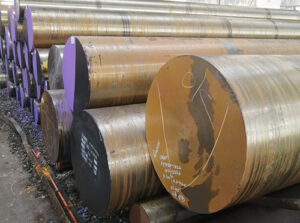AISI 431 S43100 SUS431 1.4057 Forged Stainless Steel Round Bar
Introduction
431 stainless steel is a high chromium-low nickel high hardenability Martensitic stainless steel with high strength and good corrosion resistance, as generally supplied hardened and tempered in the tensile range 850 – 1000 Mpa (condition T) Brinell range 248 – 302.
Applications
431 has been successfully used in a variety of aircraft and general industrial applications. These include fasteners, bolts, valve components and chemical equipment.
Grade Comparison
| Grade | UNS No | Old British | Euronorm | Swedish SS | Japanese JIS | ||
| BS | En | No | Name | ||||
| 431 | S43100 | 431S29 | 57 | 1.4057 | X17CrNi16-2 | 2321 | SUS 431 |
Chemical Composition
| Grade | C | Mn | Si | P | S | Cr | Ni | |
| 431 | min.
max. |
–
0.20 |
–
1 |
–
1 |
–
0.04 |
–
0.03 |
15
17 |
1.25
2.50 |
Smelting Option
1 EAF: Electric Arc Furnace
2 EAF+LF+VD: Refined-smelting and vacuum degassing
3 EAF+ESR: Electro Slag Remelting
4 EAF+PESR: protective atmosphere Electro Slag Remelting
5 VIM+PESR: Vacuum induction melting
Forming Option
1 Hot rolling process
2 Hot Forging: Electro-hydraulic; High-speed-hydraulic; Oil-hydraulic; Precision-forging
Heat-treatment Option
1 +A: Annealed (full/soft/spheroidizing)
2 +N: Normalized
3 +NT: Normalized and tempered
4 +QT: Quenched and tempered (water/oil)
5 +AT: Solution annealed
6 +P: Precipitation hardened
Suface Option
1 Black Surface
2 Grounded: Bright but rough ; Not precision
3 Machining for plate: Bright and precision; Little turning scar
4 Peeled/Turned: Bright and precision; Little turning scar
5 Polished: Very Bright and precision size; Not turning scar
Other Services
1 Cutting: Small pieces
2 CNC Machine: Produce as your drawing
3 Package: Bare/Nylon/Canvas/Wooden
4 Payment:T/T, L/C, O/A(request credit)
5 Transport:FOB/CFR/CIF/DDU/DDP (train/ship/Air)
Mechanical Properties
| Tempering Temperature (°C) | Tensile Strength (MPa) | Yield Strength 0.2% Proof (MPa) | Elongation (% in 50mm) | Hardness Brinell (HB) | Impact Charpy V (J) |
| Annealed * | 862 | 655 | 20 | 285 max | – |
| 204 | 1345 | 1055 | 20 | 388 | 50 |
| 316 | 1295 | 1035 | 19 | 375 | 53 |
| 427 | 1350 | 1080 | 19 | 388 | # |
| 538 | 1140 | 965 | 19 | 321 | # |
| 593 | 1015 | 770 | 20 | 293 | 64 |
| 650 | 960 | 695 | 20 | 277 | 84 |
Corrosion Resistance
431 stainless steel have considerable resistance to salt water, but they are less resistant to tropical water when compared to that of grade 316 steels. 431 steels have overall corrosion resistance similar to, or slightly lower than, that of grade 304 steels. 431 stainless steel with a smooth surface finish perform well in tempered and hardened conditions.
Heat Resistance
431 stainless steel are resistant to scaling at temperatures of 925°C in intermittent conditions, and 870°C during continuous operations. In general, these steels are not to be used at temperatures above standard tempering temperatures, owing to loss of mechanical properties.
Forging
Heat uniformly to 1150ºC – 1200ºC, hold until temperature is uniform throughout the section. Do not soak but commence forging immediately. Do not overheat as this will cause a loss of toughness and ductility. Do not forge below 900ºC Finished forgings should be cooled as slowly as possible in dry lime or ashes to room temperature and sub-critical annealed immediately.
Low Temperature Properties
431 stainless steel is not recommended for use at sub-zero temperatures due to a substantial drop in impact properties consistent with most steels other than the austenitic steel types.
Cold Bending
In the hardened and tempered as supplied condition will be extremely difficult due to the high yield strength and is not generally recommended.
Hot Bending
In the hardened and tempered as supplied condition it is not recommended due to its affect on the mechanical properties within the heat affected zone.
Welding
Welding of grade 431 stainless steels is difficult due to the chances of cracking. It is recommended to pre-heat the materials to 200 – 300°C before welding, and carry out post-weld heat treatment at 650°C. Welding can be performed using grade 410 filler rods.
Machining
Grade 431 steels can be easily machined in their annealed state. However, it is extremely difficult to machine these steels if they are hardened above 30HRC.

